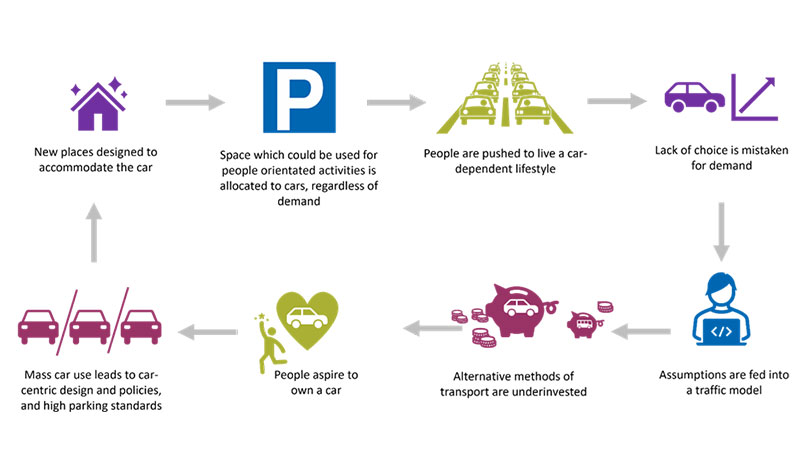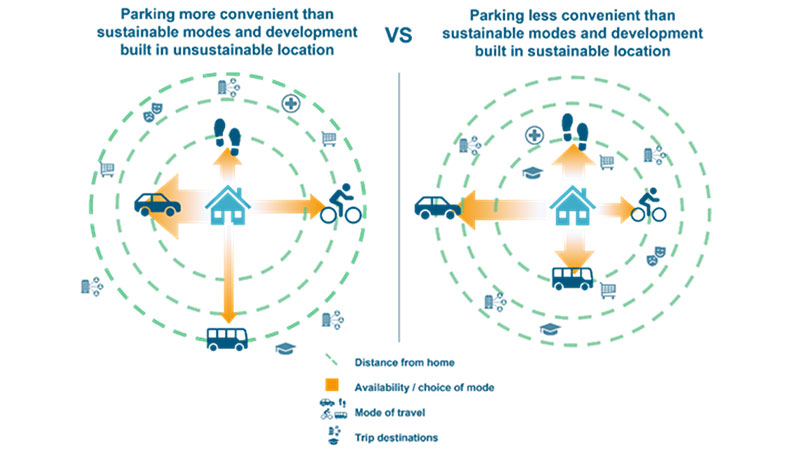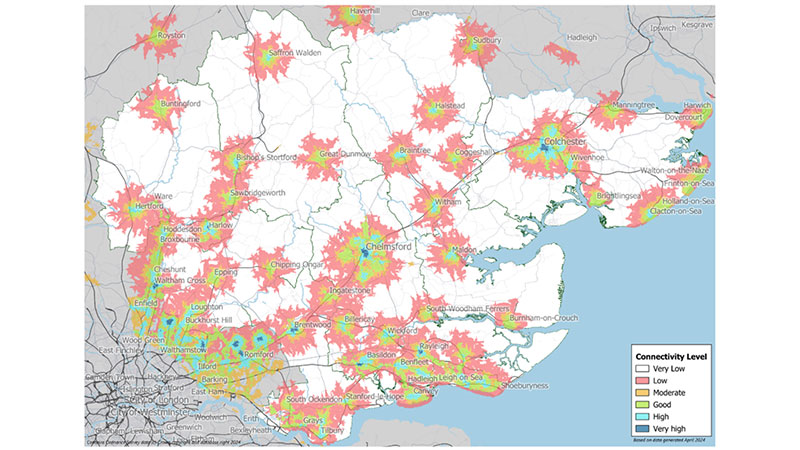Breaking the car dependency cycle in Essex

When the Essex Planning Officers Association (EPOA) and Essex County Council (ECC) commissioned us to write their new parking standards guidance, our objectives were ambitious. The new guidance needed to push the bar on sustainability, be easy to use and understand, and cater to the diverse needs of Essex.
ITP is proud to have worked with EPOA and ECC to deliver on these objectives with groundbreaking new parking guidance for Essex, setting a benchmark for sustainable development by flipping the traditional approach to defining parking standards on its head. The new guidance explores innovative solutions to accommodate parking for a range of modes and proposes a level of provision which balances parking demand with the need for quality places. The guidance is split into two parts:
Part 1:
Parking Standards Design and Good Practice (click here) – Supports applications for any type of development in Essex and provides the foundations for Part 2, including numerical standards for cycles and electric vehicles.
Part 2:
Garden Communities and Large Scale Developments (click here) – Focuses on the potential of strategic developments to deliver different sustainable mobility outcomes by virtue of their scale, critical mass and the policy frameworks in which they operate.
Why is the guidance needed?
Essex’s former parking standards were adopted 15 years ago, and a lot has changed since then – back in 2009, Elon Musk had only just received delivery of his very first roadworthy Tesla.
ECC and EPOA engaged ITP to think bigger, think better, and most importantly think differently. We saw the opportunity not just to make updates, but to help guide delivery of new sustainable developments which break the vicious cycle of car dependency:


How do we know what works?
We initially undertook a comprehensive research exercise to understand ‘what works where?’. This told us what we already suspected, but there were also unexpected insights. For instance, we found that:
- More rural areas have a higher number of cars/vans per household than more urban/denser areas, and the rate of growth of vehicles in Essex is higher than population growth, suggesting that overall car ownership per household is still increasing.
- There is not a causal relationship between car/van availability and cycling participation, but rather it is likely that these are both influenced by shared external factors such as income or availability of cycling infrastructure.
- The relationship between vehicle availability and vehicle use is not linear. Households with no vehicle availability travel by active and sustainable modes more regularly, but there is still vehicle use in these households. The change in travel mode share by rail, for example, is not proportionate to the number of vehicles available in a household; generally similar proportions travel in no or one vehicle households, but far fewer in households with two vehicles. Car passengers remain relatively similar regardless of car or van availability.
- Having more or less cars / vans in a household does not necessarily mean that more trips are made by other modes, but longer trips are often replaced by car travel.
- There are conditions that result in lower car ownership and car use such as density, proximity to urban areas, proximity to public transport (especially rail), availability of cycle infrastructure and deprivation. Whilst the latter cannot be planned, provision of genuine choice of low-cost travel options that get people where they want to go should reduce barriers to sustainable and active travel in more deprived areas.
- Car parking provision is often significantly more than car/van availability or ownership, pointing towards the issue of parking space efficiency rather than availability.
Generous parking standards at origins lead to higher car ownership and demand for parking at destinations.
“The average car spends about 80% of the time parked at home, is parked elsewhere for about 16% of the time, and is thus only actually in use (i.e. moving) for the remaining 3-4% of the time” (Source: Spaced Out: Perspectives on parking policy)
- The location of parking within developments is important and off-plot parking can have a positive impact on placemaking and reduce car dependency, if it is designed with reference to the local context. Making alternatives to the private car more convenient can reduce car dependency. By providing on-plot parking, private vehicles are often just steps from the owner’s front door, meaning that they are perceived to be the most convenient mode of transport.

How do we achieve this in Essex?
Building on the research paper, we designed a user-friendly tool which challenges the conventional ‘one-size-fits-all’ approach. This takes the baseline connectivity level of a site and combines it with other inputs such as proposed levels of public transport, active travel infrastructure and availability of local amenities. Not only is this better reconciling parking availability with potential demand, but it is also asking applicants to think about the key ingredients for sustainable development earlier in the planning process. This highlights the importance of parking in a holistic strategy and encourages iteration of proposals, as appropriate, to meet required connectivity levels.
So what? Why is this unique?
Overall, the approach used in the parking guidance is unique because it:
Is Zonal:
Conditions have been created where, even in districts with high car ownership, such as rural regions, there is the opportunity to provide restricted parking. This bucks the trend and promotes a higher mode share of sustainable transport than was ever thought possible in rural regions, demonstrating that even car-dependent regions can adopt sustainable travel habits.
Uses Parking Minimums:
The shift to parking maximums in 2001 led to issues and loopholes. Recognising that parking is costly and land hungry, and acknowledging that excessive parking will be refused, the new guidance introduces parking minimums for most land uses, varying by site connectivity. Car-free developments are suitable for highly connected areas, while parking below minimum standards is considered where appropriate. Maximum standards alone are ineffective at reducing car ownership and cause parking displacement.
Adopts a Parking Hierarchy:
The parking hierarchy is a simple and practical reference point when considering the quantum, design and provision of parking. It reflects an order of priority with active and sustainable mobility and e-mobility modes to be considered first and made most convenient, attractive and prominent followed by space for car sharing, EV charging infrastructure, and powered two-wheelers. Parking for petrol and diesel private vehicles should be provided where necessary and carefully integrated into the streetscape.
In addition to a new chapter on provision for electric vehicles, and the guidance’s emphasis on green infrastructure, green design and sustainable drainage, Part 2 introduces six overarching design principles that should guide the design of parking in new GCs and LSDs. These principles are not limited to GCs and LSDs and are intended to be prevalent throughout all new developments. The design guidance and numerical standards work to ensure that these principles are prioritised in all new developments across Essex.
The principles are:
Shared wherever possible
Accessible to all
Secure and appropriately located
Well managed outcomes
Flexible and future proof
Our experts are happy to assist you
Experts team Sustainable development
Sustainable development
Discover our vision-led approach to planning new communities to embed sustainable commuting from the outset.
